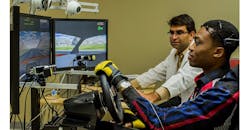ACS developing methodology for detecting driver drowsiness
Alcohol Countermeasure Systems (ACS), which specializes in breath alcohol testing technology, is studying eye-tracking data as a tool for detecting drowsiness in drivers in hopes of developing systems for detecting drowsiness in real time and providing early warning of fatigue before it leads to an accident.
“Driving is demanding—from planning and navigating a route, interacting with traffic, following road safety practices, such as maintaining appropriate speed levels to basic vehicle operation, such as changing gears, braking and even turning on windshield wipers,” said Dr Ali Shahidi Zandi, and ACS research scientist.
“Being drowsy and sleep deprived only adds more interference to an already complex task, presenting dangerous risks.”
According to the National Sleep Foundation, driving while sleep deprived is similar to driving while intoxicated. For example, staying awake for 18 hours straight can make a person drive as if their blood alcohol concentration (BAC) is .05, and a person with a BAC of .08 is considered legally impaired in the United States.
In addition to this, the National Highway Traffic Safety Administration (NHTSA) says 72,000 police-reported motor vehicle collisions on US roadways in 2015 were related to driver drowsiness, causing 41,000 injuries and 800 deaths.
Seeing the urgent need for the development of early wanting systems for monitoring drowsiness in drivers, ACS recently published an article in the SAGE Transportation Research Record based on the use of eye-tracking data as a non-intrusive measure of driver behavior. The goal of the research is to lead to the development of technologies for real-time assessment of the driver’s state of vigilance, providing early warning of fatigue, ACS said.
The ACS research study included two independent experiments involving 53 volunteers: a short morning control driving session that lasted for 10 minutes, and a longer mid-afternoon monotonous driving session that lasted for 30 minutes. Both simulated sessions included driving on a low-traffic straight highway. In each experiment, infrared-based eye-tracking systems and cameras monitored the various eye movements of participants and advanced machine-learning methodologies were employed to analyze the data and estimate the state of vigilance.
The results of the experiments verify a high correspondence between extracted eye-tracking features, and behavioral and physiological measures of vigilance, ACS said. Results also confirmed drowsy driving can be detected with high accuracy, sensitivity and specificity using eye-tracking data and an appropriate classification framework.
“With drowsy driving currently listed as one of the leading causes of motor vehicle accidents in North America, ACS research is necessary and will ultimately lead to the development of innovate, user-friendly products and services to promote road safety and keep people safe,” the company claimed.
To view the research article, visit journals.sagepub.com/doi/10.1177/0361198119847985.
